|
Introduction |
The public |
Benefactors |
Directors
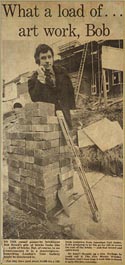 |
The public:
The Bricks controversy and 'Save the Stubbs'

Ever since the morning in August 1897 when Tate first opened, it has been an art gallery that the public has claimed as its own.
The majority of the curious visitors who streamed into the new Gallery were working men and women from the immediate neighbourhood, and groups of
schoolchildren from the local schools, rather than the usual well-heeled museum visitor.
But the public has not always supported Tate in its decisions about the works of art added to its Collection.
Two contrasting events in the 1970s: the Bricks controversy of 1976 and the Stubbs Appeal of 1977, well illustrate the very different reactions
and emotions Tate's Collection inspires.

 Press cutting, Evening Post (Luton)
Press cutting, Evening Post (Luton)
Copyright holder untraced |
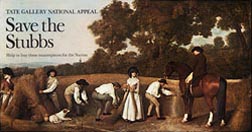
Stubbs Appeal leaflet
© Tate Archive 2003 |
|
The Bricks controversy
| ...these bricks have really brought the public in.
They can't make head or tail of them. Nothing has attracted as much attention as they have. |

Arthur Payne, Gallery Assistant, quoted in the Evening Standard, n.f.d. 1976 |
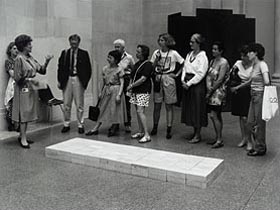 |
Equivalent VIII by Carl Andre was bought by Tate in 1972 and featured in special displays in 1974 and 1975 without attracting much publicity.
But on 15 February 1976 an article appeared in The Sunday Times about recent additions to the Tate's Collection, illustrated with a picture of
Equivalent VIII.
The sculpture, 120 firebricks arranged in a rectangular formation, an important Minimalist work, provoked uproar.
Press and public joined in a lively, and for the most part critical, debate about The Bricks , as the work became popularly known.
 Equivalent VIII, Installation View
Equivalent VIII, Installation View
© Carl Andre / VAGA, New York and DACS, London 2003 |
The Tate was ridiculed by many for, as they saw it, being conned into buying a 'pile of bricks'.
Others defended the Gallery, recognising Andre as an important artist and arguing that the Tate has to be adventurous in order to remain a major
player in the international contemporary art world.
| The Trustees of the Tate have every right to spend a little on experimental art.
I do not question their judgement. |

Hugh Jenkins, Arts Minister, Daily Mail, 18 Feb 1976 |
As a result of public and press interest, Equivalent VIII was put back on display in February 1976 until it was daubed with paint later the same month.
It returned to public view in 1977 and has been exhibited many times since, continuing to capture the imagination of the public.
Due to the publicity it has attracted it is perhaps one of the best known works of modern art in the Collection. |
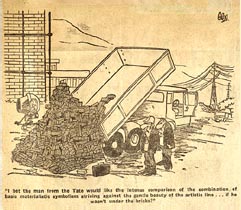
South Wales Echo cartoon, satirizing The Bricks controversy
© Western Mail and Echo |
'Save the Stubbs'
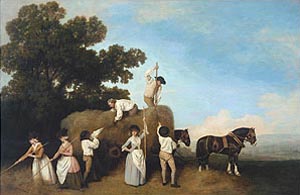
George Stubbs, Haymakers, 1785 |
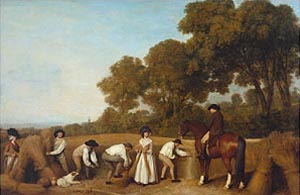
George Stubbs, Reapers, 1785 |
 |
In the year following the negative publicity surrounding The Bricks, the criticism changed to support as the Tate launched one of its most memorable
appeals 'Save the Stubbs'.
Two paintings by George Stubbs, Haymakers and Reapers, looked likely to be sold to an overseas museum unless the Tate could raise enough money to
buy them.
The appeal campaign was a tremendous success.
Competitions and lotteries were organised which, along with the thousands of donations from individuals, Trusts and companies, raised the £200,000
necessary to secure the masterpieces for the nation.
The nature of some of the donations from Trusts and companies was a little unexpected.
During a radio appeal made by the Tate's Director Norman Reid publicizing the fundraising effort, he happened
to mention that by law the first prize for a lottery was not allowed to exceed £2000 - just a little more than the cost of a mini. |
|
Stubbs Appeal crossword
Copyright holder untraced
That same day a telegram arrived at the Tate from the Managing Director of Cluff Oil offering to donate a Mini as a lottery prize.
A second offer of a Mini, from Lex Service Group followed, and a rather unusual exhibit appeared in the Tate's Duveen Sculpture Galleries!
Minis inside the Tate

© Tate Archive 2003 |
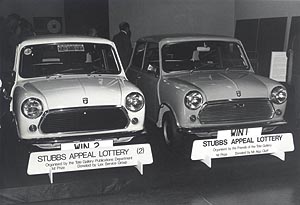 |
|
